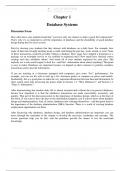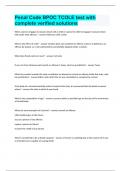Chapter 1
Database Systems
Discussion Focus
How often have your students heard that ―you have only one chance to make a good first impression?‖
That’s why it’s so important to sell the importance of databases and the desirability of good database
design during the first class session.
Start by showing your students that they interact with databases on a daily basis. For example, how
many of them have bought anything using a credit card during the past day, week, month, or year? None
of those transactions would be possible without a database. How many have shipped a document or a
package via an overnight service or via certified or registered mail? How many have checked course
catalogs and class schedules online? And surely all of your students registered for your class. Did
anybody use a web search engine to look for—and find—information about almost anything? This point
is easy to make: Databases are important because we depend on their existence to perform countless
transactions and to provide information.
If you are teaching in a classroom equipped with computers, give some ―live‖ performances. For
example, you can use the web to look up a few insurance quotes or compare car prices and models.
Incidentally, this is a good place to make the very important distinction between data and information. In
short, spend some time discussing the points made in Section 1.1, "Why Databases?" and Section 1.2
―Data vs. Information.‖
After demonstrating that modern daily life is almost inconceivable without the ever-present databases,
discuss how important it is that the (database) transactions are made successfully, accurately, and
quickly. That part of the discussion points to the importance of database design, which is at the heart of
this book. If you want to have the keys to the information kingdom, you’ll want to know about database
design and implementation. And, of course, databases don’t manage themselves—and that point leads to
the importance of the database administration (DBA) function. There is a world of exciting database
employment opportunities out there.
After discussing why databases, database design, and database administration are important, you can
move through the remainder of the chapter to develop the necessary vocabulary and concepts. The
review questions help you do that—and the problems provide the chance to test the newfound
knowledge.
© 2010 Cengage Learning. All Rights Reserved. This edition is intended for use outside of the U.S. only, with content that may be different from the U.S.
Edition. May not be scanned, copied, duplicated, or posted to a publicly accessible website, in whole or in part.
, Chapter 1 Database Systems
Answers to Review Questions
1. Discuss each of the following terms:
a. data
Raw facts from which the required information is derived. Data have little meaning unless they
are grouped in a logical manner.
b. field
A character or a group of characters (numeric or alphanumeric) that describes a specific
characteristic. A field may define a telephone number, a date, or other specific characteristics
that the end user wants to keep track of.
c. record
A logically connected set of one or more fields that describes a person, place, event, or thing. For
example, a CUSTOMER record may be composed of the fields CUST_NUMBER,
CUST_LNAME, CUST_FNAME, CUST_INITIAL, CUST_ADDRESS, CUST_CITY,
CUST_STATE, CUST_ZIPCODE, CUST_AREACODE, and CUST_PHONE.
d. file
Historically, a collection of file folders, properly tagged and kept in a filing cabinet. Although
such manual files still exist, we more commonly think of a (computer) file as a collection of
related records that contain information of interest to the end user. For example, a sales
organization is likely to keep a file containing customer data. Keep in mind that the phrase
related records reflects a relationship based on function. For example, customer data are kept in
a file named CUSTOMER. The records in this customer file are related by the fact that they all
pertain to customers. Similarly, a file named PRODUCT would contain records that describe
products—the records in this file are all related by the fact that they all pertain to products. You
would not expect to find customer data in a product file, or vice versa.
NOTE
Note: Field, record, and file are computer terms, created to help describe how data are
stored in secondary memory. Emphasize that computer file data storage does not match
the human perception of such data storage.
2
© 2010 Cengage Learning. All Rights Reserved. This edition is intended for use outside of the U.S. only, with content that may be different from the U.S.
Edition. May not be scanned, copied, duplicated, or posted to a publicly accessible website, in whole or in part.
, Chapter 1 Database Systems
2. What is data redundancy, and which characteristics of the file system can lead to it?
Data redundancy exists when unnecessarily duplicated data are found in the database. For example, a
customer's telephone number may be found in the customer file, in the sales agent file, and in the
invoice file. Data redundancy is symptomatic of a (computer) file system, given its inability to
represent and manage data relationships. Data redundancy may also be the result of poorly-designed
databases that allow the same data to be kept in different locations. (Here's another opportunity to
emphasize the need for good database design!)
3. What is data independence, and why is it lacking in file systems?
File systems exhibit data dependence because file access is dependent on a file's data characteristics.
Therefore, any time the file data characteristics are changed, the programs that access the data within
those files must be modified.
Data independence exists when changes in the data characteristics don't require changes in the
programs that access those data. File systems lack data independence because all data access
programs are subject to change when any of the file system’s data storage characteristics—such as
changing a data type—change.
4. What is a DBMS, and what are its functions?
A DBMS is best described as a collection of programs that manage the database structure and that
control shared access to the data in the database. Current DBMSes also store the relationships
between the database components; they also take care of defining the required access paths to those
components. The functions of a current-generation DBMS may be summarized as follows:
The DBMS stores the definitions of data and their relationships (metadata) in a data
dictionary; any changes made are automatically recorded in the data dictionary.
The DBMS creates the complex structures required for data storage.
The DBMS transforms entered data to conform to the data structures in item 2.
The DBMS creates a security system and enforces security within that system.
The DBMS creates complex structures that allow multiple-user access to the data.
The DBMS performs backup and data recovery procedures to ensure data safety.
The DBMS promotes and enforces integrity rules to eliminate data integrity problems.
The DBMS provides access to the data via utility programs and from programming
languages interfaces.
The DBMS provides end-user access to data within a computer network environment.
3
© 2010 Cengage Learning. All Rights Reserved. This edition is intended for use outside of the U.S. only, with content that may be different from the U.S.
Edition. May not be scanned, copied, duplicated, or posted to a publicly accessible website, in whole or in part.
, Chapter 1 Database Systems
5. What is structual independence, and why is it important?
Structural independence exists when data access programs are not subject to change when the file's
structural characteristics, such as the number or order of the columns in a table, change. Structural
independence is important because it substantially decreases programming effort and program
maintenance costs.
6. Explain the difference between data and information.
Data are raw facts. Information is processed data to reveal the meaning behind the facts. Let’s
summarize some key points:
Data constitute the building bocks of information.
Information is produced by processing data.
Information is used to reveal the meaning of data.
Good, relevant, and timely information is the key to good decision making.
Good decision making is the key to organizational survival in a global environment.
7. What is the role of a DBMS, and what are its advantages? What are its disadvantages?
A database management system (DBMS) is a collection of programs that manages the database
structure and controls access to the data stored in the database. Figure 1.2 (shown in the text)
illustrates that the DBMS serves as the intermediary between the user and the database. The DBMS
receives all application requests and translates them into the complex operations required to fulfill
those requests. The DBMS hides much of the database’s internal complexity from the application
programs and users. The application program might be written by a programmer using a
programming language such as COBOL, Visual Basic, or C++, or it might be created through a
DBMS utility program.
Having a DBMS between the end user’s applications and the database offers some important
advantages. First, the DBMS enables the data in the database to be shared among multiple
applications or users. Second, the DBMS integrates the many different users’ views of the data into
a single all-encompassing data repository.
Because data are the crucial raw material from which information is derived, you must have a good
way of managing such data. As you will discover in this book, the DBMS helps make data
management more efficient and effective. In particular, a DBMS provides advantages such as:
Improved data sharing. The DBMS helps create an environment in which end users have
better access to more and better-managed data. Such access makes it possible for end users to
respond quickly to changes in their environment.
4
© 2010 Cengage Learning. All Rights Reserved. This edition is intended for use outside of the U.S. only, with content that may be different from the U.S.
Edition. May not be scanned, copied, duplicated, or posted to a publicly accessible website, in whole or in part.





